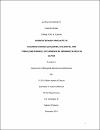Disinfection By-Products of Chlorine Dioxide (Chlorite, Chlorate, and Trihalomethanes): Occurence in Drinking Water in Qatar
| Advisor | Al Ghouti, Mohammad |
| Author | Al-Otoum, Fatima Kamel |
| Available date | 2015-05-11T10:39:34Z |
| Publication Date | 2014 |
| Abstract | The occurrence of disinfection by-products (DBPs) of chlorine dioxide (ClO₂) in drinking water, namely: chlorite, chlorate, and THMs as well as the concentration of ClO₂ were investigated. Two hundred ninety four drinking water samples were collected during the time period from March to August 2014. The water samples were collected from seven desalination plants (DPs), four resevoirs and eight mosques distributed in South and North Qatar. The ClO₂ level was ranged from 0.38 to less than 0.02 mg/L, with mean value of 0.17, 0.12, and 0.04 mg/L in the desalination plants (DPs), the reservoirs (R), and the mosques (M), respectively. The chlorite level was varied from 12.78-436.36 ppb with median values varied from 12.78 to 230.76, from 77.43 to 325.25, and from 84.73 to 436.36 ppb in the DPs, the reservoirs, and the mosques, respectively. While chlorate was varied from 10.66 ppb to 282.71 ppb with mean values varied from 35.58 to 282.72 ppb, from 11.02 to 200.69, and from 10.66 to 150.38 ppb in the DPs, R, and M respectively. However, the average value of THMs was 4.90 ppb, while maximum value reached 76.97. Lower disinfectant residual was observed in few samples, however this could be attributed to the normal decomposition reaction of ClO₂ with organic and inorganic compounds, including biofilms, pipe materials, corrosion products, formation of slime or may due to the fact the water in distribution system experience water aging problem. Significant differences were observed in the concentration level of chlorite, chlorate and THMs between DPs, reservoirs and the mosques. However, the concentrations of all DBPs fell wihtin the range of the regulatory limit set by GSO 149/2009, WHO and KAHRAMAA (KM). It is recommended to slightly increase the average ClO₂ dosage at the DPs. Such slight increase would provide safer margin at the customer point of use in case of any microbial activities. Consideration must be given to the overall demand and should account for seasonal variations, temperature, and application points. As well as a monitoring approach is recommended for the drinking water safety assessment. Re-conducting the study to include other DPs of ClO₂ is recommended. |
| Language | en |
| Subject | Water -- Purification -- Disinfection -- By-products Drinking water--Qatar |
| Type | Master Thesis |
| Department | Biological and Environmental Sciences |
Files in this item
This item appears in the following Collection(s)
-
Biological & Environmental Sciences [89 items ]


